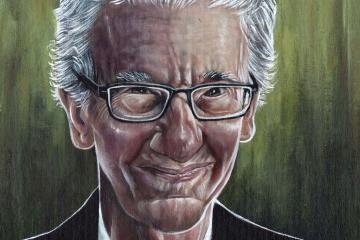Johns Hopkins pioneered the modern-day study of psychedelics in 2000 when the late Roland Griffiths, a psychiatry and neuroscience professor, launched the first FDA-approved study of psilocybin, the psychoactive ingredient in so-called magic mushrooms. Since then, ongoing Hopkins research has produced more than 150 peer-reviewed articles exploring the therapeutic promise of psychedelics in treating a range of conditions including, multiple forms of depression, PTSD, addiction disorders, anorexia nervosa, obsessive-compulsive disorder, and more. The Center for Psychedelic & Consciousness Research opened at Hopkins in 2019, cementing the institution's leadership role in the field. Today, more than 40 Hopkins researchers study the psychoactive effects and potential benefits of not only psilocybin, but other psychedelics including MDMA (ecstasy) and DMT.
Despite mounting evidence that psychedelics provide therapeutic benefits when safely administered in a controlled and medically supervised setting, most are subject to the highest level of federal restriction as controlled substances and continue to be enshrouded in public misconceptions. Pursuing such research, and funding it, remains challenging.
Video credit: Johns Hopkins University
To discuss the state of psychedelics research—its promise, policy hurdles, and potential economic impact—three Hopkins experts united on Nov. 16 for "What's Next for Psychedelics?", a virtual event open to the public and the latest offering in the ongoing Johns Hopkins Congressional Briefing Series. Participating were Frederick Barrett, director of the Center for Psychedelic and Consciousness Research and an associate professor at the Johns Hopkins School of Medicine, and Sandeep Nayak, assistant professor of psychiatry and behavioral sciences at the School of Medicine, and Matthew Eisenberg, an associate professor in the Department of Health Policy and Management at the Bloomberg School of Public Health. Lainie Rutkow, vice provost for interdisciplinary initiatives, served as moderator.
Key takeaways
Psychedelics have the potential to transform mental health treatment
"What makes it so interesting and compelling is that when this treatment works, it tends to work quickly," Nayak said. "We're talking about a treatment that is administered once to just a handful of times, which has very few precedents when it comes to the kinds of conventional treatments that you see in psychiatry or psychology. There are risks, but many of the risks can be adequately managed with appropriately selected people in carefully controlled settings."
Psychedelics could save the healthcare system a lot of money
"One in five adults in the United States have a mental illness and one in 25 have a serious mental illness … and there's just an enormous treatment gap," Eisenberg said. "About [half] the folks with mental illness in this country receive treatment in any given year. The current standard of care for treatment involves long-term use of medications as well as cognitive therapy … and is quite costly, and the standard is to stay on them for a very long time. [With] psychedelics like psilocybin, the efficacy in the clinical trials is in much shorter treatment cycles. So, when we're talking about economic impact, if that holds in the long term, it has the potential to save the healthcare system millions or billions of dollars through reduced medication costs, decreased need for inpatient care, and importantly when it comes to mental illness, less reliance on long-term disability benefits."
Psychedelics are following a different path towards wider medical use and public acceptance than marijuana
"Marijuana has broad medical and recreational applications," Eisenberg said. "Psychedelics are primarily used for specific medical treatments under really controlled healthcare settings … where administration requires professionals to be around and help the patients receive their therapy. Marijuana really took a dual pathway towards commercialization, both the medical form and the eventual promise of recreational legalization. This led to really broad commercialization and really wide market penetration across the country. Psychedelics are likely to be more integrated directly with the healthcare system akin to pharmaceutical models or in-person care models focused on therapeutic efficacy rather than wide ranging market penetration."
Psychedelics don't appear to be addictive
"Addiction, which applies to lots and lots of different drugs, typically means … people taking escalating amounts of a drug in the face of mounting consequences, social, financial, legal, or whatever, and then it just starts to control their life," Nayak said. "Maybe they're doing it every day, maybe they need to take way more of the drug to have the same effect. And you can find that pattern with alcohol, with opioids, with benzodiazepines, with all manner of drugs. But there is something that is obscured when we just call a drug a drug, right? Not all drugs behave the same way. With psychedelics, you really do not commonly see this kind of pattern. There's growing tolerance, but that doesn't lead to people taking repeated doses over and over again, chasing greater and greater highs and ruining their life. Again, I want to be very clear, there are pretty substantial risks to the use of these drugs, but classic addiction does not seem to be one of them."
Bipartisan legislation has been introduced in the House and Senate that could ease federal restrictions on psychedelics research
"One piece of bipartisan and bicameral legislation, [the Breakthrough Therapies Act], … is proposing that drugs that are schedule I [the most restrictive federal designation] that are provided with breakthrough therapy designation by the FDA be automatically rescheduled to schedule II," Barrett said. "The rationale behind this is that, by definition, schedule I drugs are [considered] incredibly toxic, highly addictive, and have no known medical use. Breakthrough therapy designation by the FDA is an acknowledgement of an up-and-coming drug that shows a high degree of early efficacy and potential. Moving from schedule I to schedule II should have minimal impact on the accessibility of these drugs outside of a controlled setting but should greatly increase the feasibility of conducting research and clinical trials on these compounds. The barriers to access for schedule I drugs for researchers are not insignificant."
The hope for psychedelics should not tip into hype
"There is the misconception that if we're studying [something], it must work, which is almost never the case in toto," Barrett said. "We're almost always studying it because we don't know if it works, or how it works, or in whom, under what circumstances, or for how long. We must be very clear to educate people coming into our clinical trials … and also the greater public … that these drugs do still absolutely hold risks. They're powerful compounds that hold great potential but are not without risk. There's a lot of excitement, there's a lot of hope, but we are trying carefully to make sure that that hope doesn't tip over into unreasonable hyper expectations."
Tune in for the full conversation via the archived video of the briefing at this link, and visit the website for the Center for Psychedelic & Consciousness Research to learn more about the center's mission.
Posted in Health, University News, Voices+Opinion, Politics+Society
Tagged psychedelics, psilocybin









